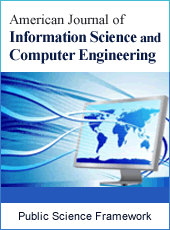American Journal of Information Science and Computer Engineering
Articles Information
American Journal of Information Science and Computer Engineering, Vol.7, No.1, Mar. 2021, Pub. Date: Mar. 29, 2021
Ultrasonic Image Processing Based on DeepLab Network
Pages: 6-15 Views: 1562 Downloads: 947
[01]
Xiaotong Li, School of Information Engineering, China University of Geosciences, Beijing, China.
[02]
Mei Li, School of Information Engineering, China University of Geosciences, Beijing, China.
[03]
Guanyi Li, School of Information Engineering, China University of Geosciences, Beijing, China.
[04]
Xinlin Yang, School of Information Engineering, China University of Geosciences, Beijing, China.
Because of its convenience and low price, ultrasound detection has been widely used in organ examination, especially in gynecological examination. Manual recognition and segmentation of the lesions in the image by the doctor is very heavy, and the doctor's manual interpretation of the image is easy to be affected by subjective cognition. Under a large amount of data, the efficiency is low and the error rate is high. In recent years, artificial intelligence technology, especially deep learning network, has made significant progress in medical image segmentation. It is widely used in lung cancer diagnosis and early prevention, but it is rarely used in ultrasound image processing. Most of the segmentation algorithms for medical images are based on the edge and region of the lesion. However, due to the complexity of medical ultrasound image structure, image interference noise, and changeable segmentation target, the existing algorithms can not achieve accurate lesion segmentation, so it has not been widely used in clinical, there are still many problems to be solved. DeepLab is a series of artificial neural networks, which aims at semantic segmentation task. Its network features can obtain more contextual information, and use fully connected conditional random field (CRF) to improve the ability of model to capture details. It is suitable for noise reduction and image segmentation of complex and noisy images. In this paper, combined with the deep learning neural network algorithm, the automatic segmentation of medical ultrasound image is studied and analyzed one by one. By comparing the processing effects of different deep learning networks, it shows that the deep lab network architecture has high recognition accuracy. The network can be widely used in image processing of complex lesions to improve the detection accuracy and efficiency.
Machine Learning, Ultrasound Image, Image Segmentation, DeepLab
[01]
Cheng Yiping.. Denoising algorithm for medical ultrasound images based on shear wave transform based on translation invariance. (Doctoral dissertation).
[02]
Yang Yuanhang. (2018). Deep learning-oriented medical image analysis system and its practice in gastroscopy video segmentation. (Doctoral dissertation).
[03]
Wang Wei. Research on image quality evaluation methods based on machine learning. (Doctoral dissertation).
[04]
Zhang Lei, Zhang Minghui, Lu Zhentai, Feng Qianjin, & Chen Wufan. (2015). Brain image segmentation based on multi-weighted probability map. Journal of Southern Medical University, 35 (008), 1143-1148.
[05]
Huang Yang. (2016). Variational level set image segmentation based on entropy. (Doctoral dissertation).
[06]
Lu Enhui. (2019). Research on image classification based on convolutional neural network. (Doctoral dissertation).
[07]
Tu Yongcheng. (2019). Research on computer-aided measurement algorithm of Cobb angle in scoliosis images. (Doctoral dissertation).
[08]
Shi Dongli, Li Qiang, & Guan Xin. (2018). Brain tumor segmentation combined with convolutional neural network and fuzzy system. Computer Science and Exploration, 012 (004), 608-617.
[09]
Rui Ting, Fei Jianchao, Zhou You, Fang Husheng, & Zhu Jingwei. (2016). Pedestrian detection based on deep convolutional neural networks. Computer Engineering and Applications, 52 (013), 162-166.
[10]
Lv Lijing. (2016). Gland segmentation in colon pathological images based on convolutional neural network. (Doctoral dissertation).
[11]
Yang Jianfeng, Hao Xiangyang, Ye Yu, Li Pengyue, & Zheng Kai. (2020). Research on cloud and snow detection method based on deepLab v3+ based on multispectral image of Tianhui-1 satellite. Science and Engineering of Surveying and Mapping (4), 40-45.
[12]
B. A. Lauze. (2014). Ultrasound image segmentation.
[13]
Qiang Kunkun, Song Qingyun, Luo Hong, Yang Taizhu, Wen Juan, & Zhang Wen et al. (2019). Ultrasound image characteristics and clinicopathological analysis of ovarian goiter. Western Medicine, 31 (04), 98-103.
[14]
Zhao Xia, & Ni Yingting. (2020). Object part segmentation network based on deepLab. Pattern recognition and artificial intelligence, v. 33; No. 201 (03), 24-33.
[15]
Xue Fei, Wu Yueqing, Yao Yu, & Ren Wei. (2019). Left ventricular ultrasound image segmentation method based on deepLab v3. Computer application.

ISSN Print: 2381-7488
ISSN Online: 2381-7496
Current Issue:
Vol. 7, Issue 3, September Submit a Manuscript Join Editorial Board Join Reviewer Team
ISSN Online: 2381-7496
Current Issue:
Vol. 7, Issue 3, September Submit a Manuscript Join Editorial Board Join Reviewer Team
| About This Journal |
| All Issues |
| Open Access |
| Indexing |
| Payment Information |
| Author Guidelines |
| Review Process |
| Publication Ethics |
| Editorial Board |
| Peer Reviewers |


